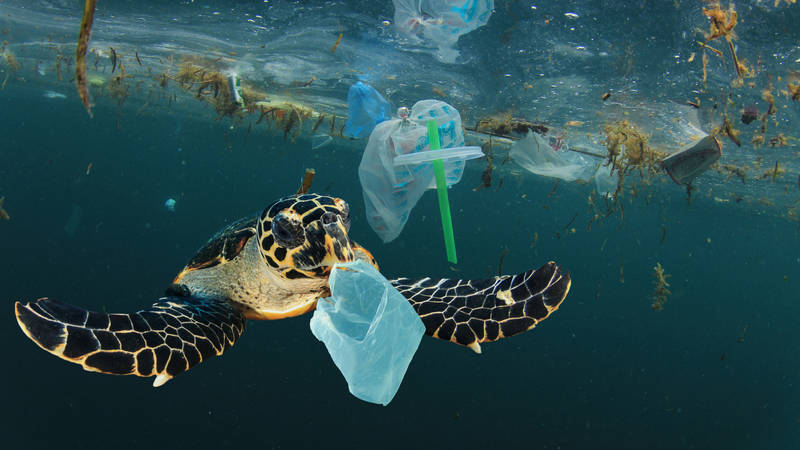Summer 2024
Vanishing Sea Meadows
The shrinking of the Laguna Madre’s seagrass beds caused by sea-level rise portends major changes in the world’s marine ecosystems.
The Laguna Madre, a shallow body of water along Texas’ southern coast, is a natural wonder. It is one of just a handful of coastal lagoons in the world with water that has a higher salt concentration than that of seawater. The lagoon, which sits in part within Padre Island National Seashore, attracts a riot of seabirds, not to mention the many other creatures that thrive below its surface.
The lagoon’s bounty is built upon an assemblage of unassuming organisms: seagrasses. These underwater meadows serve as critical habitat for endangered animals, such as Kemp’s ridley sea turtles, and several key commercial fish species, including flounder, red drum and spotted seatrout. It’s no coincidence that the Laguna Madre is a coveted fishing spot, said Kyle Capistrant-Fossa, a seagrass researcher at the University of Texas Marine Science Institute in Port Aransas. “That’s because of the abundance of the seagrasses,” he said. “Fish come into them to spawn and feed on the little fish hiding in there.”

Into The Wind
At Padre Island National Seashore, not even a gale can ruin your trip.
See more ›But Capistrant-Fossa and Ken Dunton, a professor of marine science at the institute, have found that those vital seagrass beds are shrinking rapidly. Several factors are at play, but the researchers have isolated a key culprit — sea-level rise.
Their study, published in February in the journal Communications Earth & Environment, relies on two separate datasets. One was based on data from a single site inside the park compiled by Dunton and lab manager Kim Jackson over a 30-year period. The other is the result of surveys conducted by the research team between 2011 and 2022 at nearly 150 sites across the Laguna Madre — including dozens within the park’s boundaries. The researchers waded, snorkeled and dove below the surface to determine whether seagrasses were present. The most dramatic declines were observed in so-called deep-edge sites, between 1.5 and 2 meters deep — a depth right at the margin of habitability for the seagrass species of the Laguna Madre. In 2013, they found seagrasses at 80% of these sites, but in 2022, they detected seagrasses in only 4% of the same areas. “They just needed that little bit, and then they were at the tipping point,” Capistrant-Fossa said. “The change we saw there was really dramatic.”
It’s hard to overstate the ecological importance of seagrass. Manatees, known as sea cows, graze on seagrasses for hours on end. The dwarf seahorse, native to the Laguna Madre, uses the meadows to anchor itself, wrapping its prehensile tail around individual blades to keep from drifting away. Every winter, migratory birds from Canada and the northern U.S. stop to feed on the lagoon’s seagrasses or the animals living in its waters. One of the most striking of the Laguna Madre’s year-round denizens is the roseate spoonbill, which stalks the shores like a technicolor dinosaur.

A dwarf seahorse. This approximately 1-inch-long species is the third-smallest seahorse in the world.
©JEFFREY JEFFORDSIn addition to providing rich habitat, seagrasses store massive amounts of carbon. By one estimate, a single square kilometer of seagrass can store up to 83,000 metric tons of carbon per year — roughly three times as much as a similarly sized parcel of forest. Robust seagrass beds also function like terrestrial plants, holding undersea soil together and preventing coastal erosion.
Yet due to a host of factors — many of which are exacerbated by climate change — including disease, urbanization, pollution, seabed disturbance, algal blooms, drought, ocean acidification and rising sea temperatures, the world’s seagrasses are today among the planet’s most threatened marine habitats. Since the mid-1700s, nearly one-third of the ocean’s seagrass beds have been lost. A 2009 estimate posits that as much as 7% of what remains is lost every year. Of the world’s 70-some seagrass species, 20% are at risk, according to the International Union for Conservation of Nature. The loss of seagrasses is ominous because “like flowering plants, they are at the base of the food chain,” said Barnabas Daru, an assistant professor of biology at Stanford University. “Everything in the marine ecosystem depends directly or indirectly on these foundational species. Without them, the ecosystems in the marine environment will crash.”

Turtle Troubles
New research from Padre Island National Seashore highlights the toll that ingesting plastic is taking on green sea turtles.
See more ›Like their terrestrial counterparts, seagrasses not only flower and reproduce via pollination, but they are also photosynthetic, transforming sunlight into cellular energy. That dependence on the sun means that they are highly sensitive to water depth and clarity. Many seagrass species thrive in water 1 to 3 meters deep, though outliers such as Caribbean seagrass can grow in waters more than 60 meters deep. As sea levels rise, the amount of sunlight reaching the ocean floor diminishes. A 10-centimeter rise can result in a 10% to 20% loss of sunlight energy reaching the seafloor, particularly in a place such as the Laguna Madre, where the water is turbid.
The changes the team documented at the Laguna Madre are stark. When Capistrant-Fossa began working on the project in 2021, he met with Jackson, who told him about the changing conditions in the lagoon over the years. “She said when she first started going out there, the water depth was about mid-waist to the lower chest,” he said. But in more recent visits, Jackson had to stand on a milk crate in some places to keep her head above the waterline. “In other areas, it was above her head.”
As it happens, ocean levels are rising between two and three times faster along the Gulf Coast than the global average. (That rapid rise may be linked in part to land sinking as a result of oil and gas extraction along the coast, according to the study.) Capistrant-Fossa and Dutton’s research revealed that the sea level in the Laguna Madre has risen by roughly 14 millimeters per year since 2014. That increase has translated into a reduction in solar energy, which has triggered a loss of seagrass across the Laguna Madre. In 2011, 5% of the sites the team monitored had no seagrass. “By 2020,” said Capistrant-Fossa, “25% had no seagrass.”

National Parks
You can read this and other stories about history, nature, culture, art, conservation, travel, science and more in National Parks magazine. Your tax-deductible membership donation of $25 or more entitles…
See more ›Capistrant-Fossa said there could be a silver lining in the potential for these marine plants to colonize new areas of land inundated by the advancing oceans. But while the Laguna Madre has space to grow, the availability of new habitat in more populated regions has been severely limited by sea walls, breakwaters and other structures designed to protect coastal areas from rising sea levels. “That’s one of the big unknowns,” Capistrant-Fossa said. “Will seagrasses be able to colonize this new land as it floods?”
The situation unfolding in the Laguna Madre, Capistrant-Fossa said, is a wakeup call for the future of seagrass beds worldwide. “In all the scientific literature you read, everyone’s talking about sea-level rise as a problem in the future, for 2050, for 2100,” he said. “But what we saw in the Laguna Madre drove home the point that the effects are already visible in the present. This is not a future problem. Sea-level rise is now.”
About the author
-
 Jeremy Miller Contributor
Jeremy Miller ContributorJeremy Miller is a writer in Richmond, California. His recent writing has appeared in numerous publications, including Harper’s Magazine, The New Yorker, Outside, Orion and bioGraphic.



